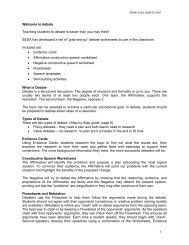Effective Cross-Examination - Saskatchewan Elocution and Debate ...
Effective Cross-Examination - Saskatchewan Elocution and Debate ...
Effective Cross-Examination - Saskatchewan Elocution and Debate ...
You also want an ePaper? Increase the reach of your titles
YUMPU automatically turns print PDFs into web optimized ePapers that Google loves.
<strong>Saskatchewan</strong> <strong>Elocution</strong> <strong>and</strong> <strong>Debate</strong> Association (SEDA)<br />
Ten Tips for <strong>Effective</strong> <strong>Cross</strong>-<strong>Examination</strong><br />
1. THE PURPOSE OF CROSS-EXAMINATION<br />
• performance for the judges<br />
• build your case<br />
• obtain admissions from the opposing side which are helpful to your own case,<br />
• obtain admissions from the other side which can be used to hurt their own case<br />
• clarify a point made by the other side<br />
2. OPEN ENDED QUESTIONS<br />
• use sparingly when you can<br />
• can reasonably limit the extent of the response<br />
• are fairly certain that you anticipate the general nature of the answer that you will get<br />
• can then use a direct quote of the respondent's own answer to ask leading questions<br />
Examples of open ended questions are:<br />
• What is your plan?<br />
• Do you have any authority for your statements?<br />
• Why do you feel that this is a problem?<br />
• How can you pay for this?<br />
3. LEADING QUESTIONS<br />
Leading questions suggest the intended answer.<br />
Leading questions are designed to get you to agree with something that will harm your case or help the<br />
questioner's case.<br />
A good questioner will ask a series of leading questions with a view to getting the respondent to agree<br />
with him for the first few questions. After lulling the respondent into a pattern of agreement, the<br />
questioner may pose a target question, hoping to have thrown the respondent off her feet, <strong>and</strong> have her<br />
agree before realizing what has been admitted to. Once the questioner has received the favourable<br />
answer, he will immediately move to a new line of inquiry, distracting the respondent, <strong>and</strong> forcing her to<br />
concentrate upon a different topic before she has an opportunity to elaborate upon her earlier, harmful,<br />
admission. The witness would look foolish or unreasonable if they try to disagree with obvious or factual<br />
questions<br />
• Ask short, leading questions because they show the judges what answer you want<br />
• Decide what admissions you want from the witness <strong>and</strong> make it a leading question<br />
• Turn the question around<br />
• Limit yourself to factual questions<br />
• Don't argue<br />
• Tie answers down<br />
• Know when to leave answers alone<br />
• Ask in positive form<br />
• Ask a Series of Questions<br />
• Show Relevance<br />
• Don't back down<br />
• Consider the order of Questions<br />
• Try to predict an answer to a question<br />
• Don't ask a question if you don’t know the answer or there is no advantage<br />
4. COURTESY IN CROSS-EXAMINATION<br />
• be courteous, but not meek<br />
• Do not seek to embarrass, belittle or intimidate one's opponent but challenge answers <strong>and</strong> nonresponses
5. SPEECH MAKING IN CROSS-EXAMINATION<br />
• Do not give a lengthy recitation of new information then make it sound like a question at the end<br />
6. CONTROL OF CROSS-EXAMINATION<br />
• The questioner has the right to control the cross-examination<br />
• The respondent has the right to qualify his or her answer<br />
Avoid any discussion of your own beliefs, which are in fact irrelevant. A debate is a clash of positions,<br />
<strong>and</strong> you need not say whether you personally support the case that you are presenting.<br />
7. STRATEGY IN CROSS-EXAMINATION<br />
Choose your questions <strong>and</strong> strategy based on some of these factors:<br />
• Is the other side disorganized?<br />
• Is their research inferior to yours?<br />
• Are they prone to being argumentative <strong>and</strong> belligerent?<br />
• Are they operating poorly as a team?<br />
• Does your own case need more factual support?<br />
• Has your partner been undermined by a powerful cross-examination?<br />
• Do you need to change the tone <strong>and</strong> pace of the debate?<br />
8. QUESTION TREES<br />
For each area that you intend to examine upon, prepare a separate sheet of paper. At the top of the sheet,<br />
write the first question which you will ask. Then divide the sheet in half <strong>and</strong> record what your will next<br />
question will be if the first question is answered with a yes, <strong>and</strong> what your question will be if it is<br />
answered with a no. Continue on like that until you have mapped out a course which must necessarily<br />
lead to a harmful admission, or which has taken the respondent to an absurd extreme, which will destroy<br />
his or her credibility.<br />
Drawbacks:<br />
• work best with questions that can only be answered with a yes or no<br />
• can be frustrated by a properly qualified answer<br />
• do not prepare you to depart from your advance plan<br />
• sound canned<br />
9. MAKING USE OF THE CROSS EXAMINATION<br />
State the conclusions about the admissions you <strong>and</strong> your partner have obtained from the opposition, in a<br />
subsequent constructive or rebuttal speech. This is most effective when prefaced with one of the<br />
following phrases:<br />
• As the first affirmative speaker admitted to my partner under cross-examination...<br />
• My opponent stated during cross-examination that...<br />
• Recall that the negative admitted our second need for change in crossexamination<br />
when they stated...<br />
10. Answering questions<br />
Your objective as witness is the same as your objective as examiner: to create a favorable impression with<br />
the audience:<br />
• Listen to the question carefully - but don't stall;<br />
• Ask for clarification or which question to answer if several are offered at once<br />
• Answer the question truthfully, <strong>and</strong> briefly (less likely to make damaging admissions)<br />
• Don’t appear evasive<br />
• Don't make speeches<br />
• Tell the truth <strong>and</strong> be (<strong>and</strong> convey the impression of being) forthright<br />
Summary of articles by Richard N. Billington <strong>and</strong> Brian Casey. Visit www.saskdebate.com for complete texts <strong>and</strong> examples.





